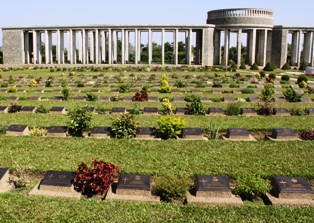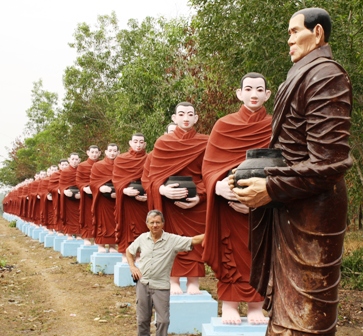
Click the photo above to see an album of photos. To return to our website close the window.
Read previous Delta Temples and Caves
Friday 22 January 2010 Mawlamyine
Have you ever heard of a water park as part of a religious complex? Well we hadn’t until we visited Win Sein Taw Ya, just south of the town of Mawlamyine. There lies a recently constructed 560 ft long reclining Buddha, currently under repair, with a Buddha museum built into the base. Right next to the Buddha is a water park with four long slides, also under repair. The most interesting aspect for us was the line of 500 statues of monks leading the way to the complex. Even under repair the site is a popular outing for Myanmar people.
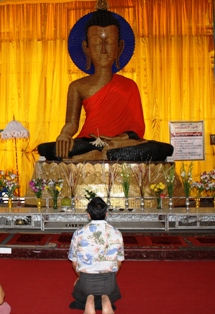
Just as we left Mawlamyine we started to have car problems. The car started to shudder and balk. It was dirty gas that caused the problems. This is understandable given that the car is 25 years old and gas is sold in 1 quart whiskey bottles from small roadside stands. A friendly local jumped on his motorcycle when he heard of our problems and led us to a mechanic nearby. There the filter was cleaned and we were on our way again, except the problem promptly returned. We limped to a stop in front of a simple restaurant run by a woman in front of her family home. Another mechanic was summoned and a new filter was purchased. Thant Zin and the mechanic installed the new filter. In the meantime Ray, Twinkle and I were enjoying a lunch of Myanmar salad, rice and curry. When he was finished, Thant Zin joined us. Ray and paid for the lunch as a treat. It cost just 1800 K ($1.80) for all four of us!
This time we made it to our destination of Kinpun, the closest town to the famous Golden Rock. On top of a high mountain is a balancing rock, covered in gold leaf, with a golden temple on top. Thant Zin told us that according to legend, the rock was once suspended 8 inches above the base. Over time it settled on the base and is kept on the base by the two hairs from the Buddha that are entombed in the rock. Even if you don’t believe the legend, thousands do and come by the hundreds every day to worship at the rock. The best time to visit the rock is at either sunrise or sunset. To do so you must stay at a very expensive hotel at the summit of the mountain. You cannot get to the summit from Kinpun in time for either sunrise or sunset. We opted to stay in the village and content ourselves with a morning visit.
To reach the Golden Rock is not easy. You have an option of a four to six hour hike, one way to the summit of the mountain or you can take a 45 minute truck ride part way and walk the last 45 minutes to the summit. We took the truck option but I would not recommend doing this every day. The truck is outfitted with wooden benches set in parallel rows in the box. The rows are so tight together that people with legs as long as mine, which is not very long, must sit sideways to fit in.
Our trip up was a little better than the return trip. Going up the four of us, Ray, me, Twinkle and Thant Zin, took the rear bench which had the best legroom. Going down I endured the second to last row. The truck does not leave until it is full, and I mean really full. Each bench must have six passengers, and the five more expensive seats inside the cab behind the driver must be full. We estimated there were 55 passengers in each truck. It took about 40 minutes before it was deemed that our truck and a second one were full enough to depart. Off we went into the hills, following sharp switchbacks and slowing for trucks coming down. After 30 minutes we reached the half way station were we had a break. The rest of the trip was on roads only wide enough to allow one-way traffic. We had to wait until a convey of trucks came down to our point before our convoy of, by that time, three trucks could go the rest of the way. At the next truck station we all had to get out and walk. Some trucks do go all the way but only locals are allowed on them, no foreigners. That was fine with us.
We had our walking shoes on and had our hiking poles to help up the steep paved road to the summit. I even refused a litter ride up, to the disappointment of the four men who would have carried me the rest of the way, for a fee. It was warm but we had water with us. There were several interesting stalls by the side of the road selling traditional medicine, including bowls of bark, herbs and dried scorpions and centipedes. One man at one of the stalls had a “pet” centipede to show us. It was almost a foot long and liked to run up the man’s arm. Thant Zin told us the man removes the centipede’s teeth to avoid the poisonous bite.
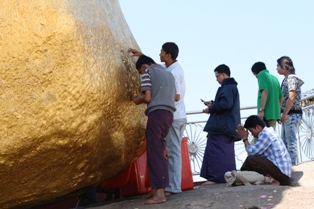
Adjacent to the area of the rock was a food court with a long line of restaurants bordering a walkway. I don’t think they had many customers that day as our appearance set off a clamour of voices all beckoning us to their restaurant. We let Thant Zin and Twinkle choose for us as they make this trip often, by themselves and with other clients. At the end of the restaurant area was another small monastery on the edge of the mountain. Next to the monastery were three newly painted helicopter pads. At one time you could charter a helicopter to take you to the Golden Rock but now they are reserved for military visitors.
We walked back down the mountain and got the next truck going to Kinpun. Back in town we returned to our hotel, intending to have a peaceful afternoon and evening before returning to Yangon the next day. It was not as peaceful as I would have liked. There was a wedding going on at a private house very near our hotel. It is traditional to have a DJ with music to entertain the guests. The problem is the wedding party has never acknowledged a noise pollution level. It was deafening and continued until 9:30 PM. If that wasn’t bad enough, the music started up again just after 4:00 AM! I quickly found my earplugs and managed to go back to sleep. The moral of this story is to ask if there are any weddings scheduled for the immediate vicinity and find so place else to stay if there are!
You would think we had seen enough Buddhas on our trip by this time but there was one more visit to make. Bago, about two hours from Yangon, is a former capital of Myanmar. It was founded in 573 AD by two Mon princes and over the next 1200 years lost and regained its status as a capital. A siege by a neighbouring King in 1757 destroyed the city. The city was rebuilt but finally lost its status as a seaport and capital for good when the river beside the city changed its course in the 19th C and the city was cut off from the sea. It is now just a busy, not very attractive town, but it does have some interesting temples and monasteries.
Kha Khat Wain Kyaung is one of the three largest monasteries in Myanmar. Similar to Maha Ganayon Kyaug monastery in Amarapura, outside Mandalay, the daily spectacle of watching hundreds of monks line up for their meal has become a tourist attraction. We were there to witness the event and, I must admit, it was very interesting. We were there early enough to see the kitchens where huge vats of food are prepared every day for the 600 or so monks who stay there. We had a look at the dining room, set up with bowls of vegetable curry and Myanmar salad on low round tables. Thant Zin pointed out a statue of Aung San on a horse in a garden next to the entrance to the dining room. Besides being the father of Aung San Suu Kyi, he is revered as a hero of the independence movement following WWII.
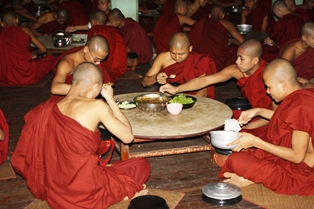
Bago did have a few temples to interest us. My favourite was another huge reclining Buddha. The Shwethalyaung Buddha, of unknown vintage, was lost during the destruction of Bago in 1757. It lay hidden in the jungle until it was rediscovered in 1880, renovated and moved to its current home. I walked around the back of the Buddha to find the area covered with school children, on a school trip from Yangon, all sitting on the floor eating lunch under the direction of their teachers.
